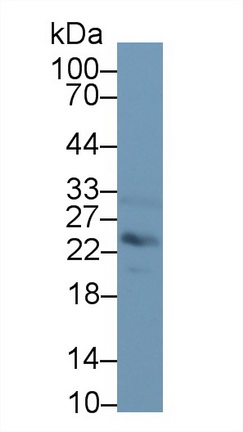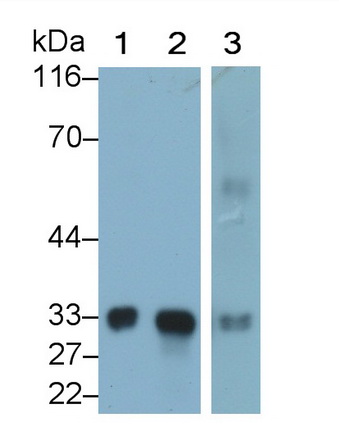Polyclonal Antibody to Mannose Binding Lectin (MBL) 

MBL2; COLEC1; HSMBPC; MBP1; MBP; Collectin-1; Mannose-binding protein C; Mannan Binding Protein; Mannose-Binding Lectin(Protein C)2,Soluble(Opsonic Defect)
Overview
Properties
- Product No.PAB480Ga01
- Organism SpeciesChicken (Gallus) Same name, Different species.
- ApplicationsWB
If the antibody is used in flow cytometry, please check FCM antibodies.
Research use only - DownloadInstruction Manual
- CategorySignal transductionInfection immunityImmune molecule
- SourcePolyclonal antibody preparation, Host Rabbit
- Ig Type IgG, Potency n/a
- PurificationAntigen-specific affinity chromatography followed by Protein A affinity chromatography
- LabelNone
- Immunogen RPB480Ga01-Recombinant Mannose Binding Lectin (MBL)
- Buffer Formulation0.01M PBS, pH7.4, containing 0.05% Proclin-300, 50% glycerol.
- TraitsLiquid, Concentration 0.5mg/ml
Sign into your account
Share a new citation as an author
Upload your experimental result
Review

Contact us
Please fill in the blank.
Specifity
The antibody is a rabbit polyclonal antibody raised against MBL. It has been selected for its ability to recognize MBL in immunohistochemical staining and western blotting.
Usage
Western blotting: 0.01-2µg/mL;
Optimal working dilutions must be determined by end user.
Storage
Store at 4°C for frequent use. Stored at -20°C in a manual defrost freezer for two year without detectable loss of activity. Avoid repeated freeze-thaw cycles.
Stability
The thermal stability is described by the loss rate. The loss rate was determined by accelerated thermal degradation test, that is, incubate the protein at 37°C for 48h, and no obvious degradation and precipitation were observed. The loss rate is less than 5% within the expiration date under appropriate storage condition.
Organism Species More: Rattus norvegicus (Rat)Giveaways
Increment services
-
 Antibody Labeling Customized Service
Antibody Labeling Customized Service
-
 Protein A/G Purification Column
Protein A/G Purification Column
-
 Staining Solution for Cells and Tissue
Staining Solution for Cells and Tissue
-
 Positive Control for Antibody
Positive Control for Antibody
-
 Tissue/Sections Customized Service
Tissue/Sections Customized Service
-
 Phosphorylated Antibody Customized Service
Phosphorylated Antibody Customized Service
-
 Western Blot (WB) Experiment Service
Western Blot (WB) Experiment Service
-
 Immunohistochemistry (IHC) Experiment Service
Immunohistochemistry (IHC) Experiment Service
-
 Immunocytochemistry (ICC) Experiment Service
Immunocytochemistry (ICC) Experiment Service
-
 Flow Cytometry (FCM) Experiment Service
Flow Cytometry (FCM) Experiment Service
-
 Immunoprecipitation (IP) Experiment Service
Immunoprecipitation (IP) Experiment Service
-
 Immunofluorescence (IF) Experiment Service
Immunofluorescence (IF) Experiment Service
-
 Buffer
Buffer
-
 DAB Chromogen Kit
DAB Chromogen Kit
-
 SABC Kit
SABC Kit
-
 Long-arm Biotin Labeling Kit
Long-arm Biotin Labeling Kit
-
 Real Time PCR Experimental Service
Real Time PCR Experimental Service
Citations
- Analysis of the Urine Proteome of Human Contrast-Induced Kidney Injury Using Two-Dimensional Fluorescence Differential Gel Electrophoresis/Matrix-Assisted Laser Desorption Time-of-Flight Mass Spectrometry/Liquid Chromatography Mass Spectrometry. Karger: 000255439
- Serum Levels and H/L Gene Polymorphism of Mannose-Binding Lectin in Primary Open Angle GlaucomaIngenta: art00007
- Complement activation contributes to the injury and outcome of kidney in human anti-glomerular basement membrane disease.PubMed: 22941511
- Urinary mannose-binding lectin is a biomarker for predicting the progression of immunoglobulin (Ig)A nephropathyPubMed: PMC3406374
- Alternative Complement Pathway Activation Products in Urine and Kidneys of Patients with ANCA-Associated GNPubmed: 24115193
- Novel findings on the role of ficolins and colectins in the innate response against Leishmania braziliensisPubmed: 32827456
- Complement activation profile of patients with primary focal segmental glomerulosclerosisPubmed: 32569286
- The lectin pathway of complement and the initial recognition of Leishmania infantum promastigotes34242658







